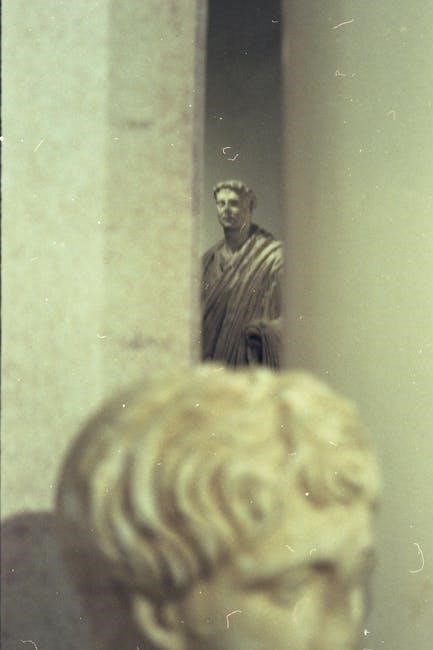
1962 Roman Missal PDF: Overview
The 1962 Roman Missal‚ a key liturgical text‚ is now widely available in PDF format. This digital accessibility allows faithful individuals to study and engage with the Traditional Latin Mass more readily‚ offering convenient access.
Significance and Historical Context
The 1962 Roman Missal holds immense significance as the final edition promulgated before the liturgical reforms that followed Vatican II. Issued by Pope John XXIII‚ it represents a pivotal moment in liturgical history‚ solidifying a specific form of the Traditional Latin Mass (TLM). Its historical context is rooted in centuries of liturgical development‚ and it stands as a testament to the practices and traditions cherished by many Catholics before the sweeping changes introduced in later editions. It remains a touchstone for those devoted to the pre-Vatican II liturgy.
Availability of the 1962 Roman Missal in PDF Format
The 1962 Roman Missal is readily accessible in PDF format across various online platforms. This digital availability allows faithful individuals easy access to the texts for study and liturgical use.
Online Sources for Download
Several websites offer the 1962 Roman Missal in PDF format for download‚ catering to those interested in the Traditional Latin Mass. Notable sources include the Church Music Association of America (CMAA) and the Fatima Movement Digital Library‚ which hosts a color version of the Missal. SanctaMissa is another site offering the Missal in PDF form. These digital versions often include features such as searchable text and high-quality scans‚ making them valuable resources for clergy‚ scholars‚ and laity alike. These sources provide an accessible means to engage with this liturgical text.
Features of the 1962 Roman Missal
The 1962 Roman Missal features both Latin and English translations‚ providing access to a wide range of users. It contains the Ordinary and Propers of the Mass‚ essential for liturgical celebrations.
Language: Latin and English Translations
The 1962 Roman Missal is predominantly in Latin‚ the traditional language of the Roman Rite. To aid understanding and participation‚ many editions include parallel English translations. This assists those unfamiliar with Latin to follow the Mass‚ and readings. The English translations typically utilize the Douay-Rheims Bible for Scriptural passages. The dual-language format enhances accessibility‚ and ensures wider engagement. This is especially helpful for personal study and participation in the Traditional Latin Mass.
Content: Ordinary and Propers of the Mass
The 1962 Roman Missal encompasses two main sections: the Ordinary and the Propers. The Ordinary contains fixed prayers and chants recited in every Mass‚ such as the Kyrie‚ Gloria‚ Credo‚ Sanctus‚ and Agnus Dei. The Propers‚ however‚ vary depending on the liturgical season‚ feast day‚ or particular occasion. This includes the Introit‚ Collect‚ Epistle‚ Gospel‚ Offertory‚ Communion‚ and Postcommunion prayers. Together‚ these components provide the complete texts needed for celebrating Mass according to the 1962 liturgical norms.
Instructions for Use
The 1962 Roman Missal includes detailed instructions for celebrating Mass. These directives cover aspects of both Low Mass (Missa Lecta) and High Mass (Missa Cantata)‚ providing guidance on the correct performance of the rites.
Guidance for Low and High Mass
The 1962 Roman Missal provides comprehensive guidance for both Low Mass (Missa Lecta) and High Mass (Missa Cantata)‚ clarifying the roles of the priest and servers. Low Mass involves the priest reciting the prayers‚ while High Mass includes chanting. The missal outlines specific actions‚ prayers‚ and chants for each form. These instructions ensure accurate adherence to traditional liturgical practices‚ aiding in the proper celebration of the Traditional Latin Mass. The missal helps understand the distinctions and requirements for each type of Mass.
Explanation of Symbols (P: for Priest‚ S: for Servers)
To facilitate understanding and proper execution of the Mass‚ the 1962 Roman Missal employs specific symbols. “P:” denotes actions or words spoken exclusively by the priest during the service‚ guiding him through his parts. Similarly‚ “S:” indicates the responses or actions designated for the servers assisting at the altar. These symbols clarify roles and responsibilities within the liturgy. This system ensures a clear understanding of who performs which part. By understanding these‚ participants can follow the Mass accurately.
Liturgical Calendar and Feasts
The 1962 Roman Missal includes a liturgical calendar outlining specific feasts and observances throughout the year. This calendar guides the celebration of various saints’ days and other significant liturgical events‚ enriching spiritual life.
Feasts Occurring on Sundays and Holy Days
The 1962 Roman Missal details which feasts can occur on Sundays and Holy Days in the Extraordinary Form‚ crucial for Traditional Latin Mass Catholics. These feasts‚ included in the St. Campion Missal & Hymnal‚ dictate specific liturgical observances. Understanding the interplay between fixed and movable feasts is essential for proper liturgical planning. The Missal provides clear guidance on how to navigate these occurrences‚ ensuring the correct propers are used during Mass. This careful attention to the liturgical calendar enriches the faithful’s experience of the Church’s liturgical year.
The 1962 Roman Missal and Tradition
The 1962 Roman Missal holds immense importance within Catholic tradition. It represents a significant link to pre-Vatican II liturgical practices‚ particularly for those who cherish the Traditional Latin Mass.
Relevance to Traditional Latin Mass (TLM)
The 1962 Roman Missal serves as the definitive liturgical book for the Traditional Latin Mass (TLM)‚ also known as the Extraordinary Form of the Roman Rite. Its texts and rubrics dictate the prayers‚ readings‚ and ceremonies of this form of worship. The Missal ensures the proper celebration according to the traditions that existed before the liturgical reforms following the Second Vatican Council. For adherents of the TLM‚ the 1962 Missal is indispensable.

Resources and Supplements
Beyond the core Missal‚ supplementary materials enhance understanding and participation. These resources include guides for pronunciation‚ explanations of liturgical symbols‚ and collections of Gregorian chant settings‚ which enrich the liturgical experience.
Gregorian Chant Settings
The 1962 Roman Missal often includes Gregorian Chant settings to enhance the liturgical experience‚ providing musical scores for various parts of the Mass. These settings‚ typically in square notation‚ are essential for the sung portions of the Mass‚ such as the Kyrie‚ Gloria‚ Credo‚ Sanctus‚ and Agnus Dei. Resources often feature settings for multiple Masses‚ including Credo I and III‚ along with the before-Mass Sprinkling Rite‚ aiding both clergy and choir in performing the traditional chants. These musical supplements preserve the solemnity and beauty of the liturgy.
Accessibility and Digital Preservation
High-quality color scans and digitized versions of the 1962 Roman Missal ensure its accessibility and preservation. These digital formats allow for easy distribution and long-term storage of this important liturgical resource.
Color Scans and Digitized Versions
The availability of the 1962 Roman Missal in color-scanned and digitized versions marks a significant advancement in accessibility. Previously‚ only black and white versions were widely accessible‚ limiting the experience for users. The Fatima Movement Digital Library pioneered this effort‚ offering the first color version online. These high-quality scans preserve the original’s detail and beauty‚ ensuring future generations can study the Missal. Digital preservation protects against physical degradation‚ making this essential liturgical resource readily available for study and practice. The Church Music Association of America also provided invaluable contributions.

The 1962 Roman Missal vs. Later Editions
The 1962 Roman Missal differs significantly from later editions‚ reflecting different liturgical reforms. These variations impact the texts‚ prayers‚ and overall structure of the Mass‚ which holds considerable theological weight.
Differences and Significance
The key differences between the 1962 Roman Missal and subsequent editions primarily involve liturgical reforms implemented after Vatican II. The 1962 Missal‚ representing the Tridentine Mass‚ maintains Latin as the primary language and includes specific prayers and rubrics absent in later versions. These distinctions carry significant theological and cultural weight for those attached to the Traditional Latin Mass. Changes include alterations to the liturgical calendar‚ the simplification of certain rites‚ and a shift towards vernacular languages‚ all contributing to a different experience of the Mass.

Papal Documents and the 1962 Missal
Papal documents‚ especially Summorum Pontificum‚ significantly influence the use of the 1962 Missal. This document allows for broader celebration of the Traditional Latin Mass‚ highlighting its enduring importance within the Church.
Motu Proprio Summorum Pontificum
Summorum Pontificum‚ a motu proprio issued by Pope Benedict XVI‚ plays a vital role in the accessibility and usage of the 1962 Roman Missal. This document acknowledges the Missal promulgated by St. Pius V and reissued by Bl. John XXIII as an extraordinary form of the Roman Rite. It grants priests greater freedom to celebrate Mass according to the 1962 Missal‚ recognizing the value and sacredness that earlier generations held. The motu proprio emphasizes that what was once considered sacred remains sacred and great for us too;
Online Communities and Resources
Several online communities and resources offer support and information regarding the 1962 Roman Missal. These platforms provide valuable insights‚ guidance‚ and a sense of community for those interested in traditional liturgical practices.
Websites Offering Information and Support
Numerous websites provide information and support for those interested in the 1962 Roman Missal and the Traditional Latin Mass. These sites often feature downloadable PDFs of the Missal‚ guides on usage‚ and explanations of liturgical practices. Communities like the Church Music Association of America (CMAA) and SanctaMissa offer invaluable resources. Users can find discussions‚ articles‚ and practical assistance for understanding and participating in the liturgical traditions associated with the 1962 Missal‚ fostering a deeper connection to the historic liturgy.

Legal and Liturgical Considerations
The use of the 1962 Roman Missal is subject to specific legal and liturgical norms. Regulations‚ permissions‚ and papal documents‚ like Summorum Pontificum‚ govern its celebration within the Catholic Church.
Regulations and Permissions for Use
Using the 1962 Roman Missal requires adherence to specific regulations‚ often outlined in documents like Summorum Pontificum. Depending on the setting and context‚ permissions from ecclesiastical authorities‚ such as diocesan bishops or the Dicastery‚ may be necessary‚ especially for celebrations in parish churches. It is essential to understand the current norms governing its usage to ensure liturgical celebrations align with the Church’s directives. These considerations uphold the proper and respectful use of this liturgical resource.


